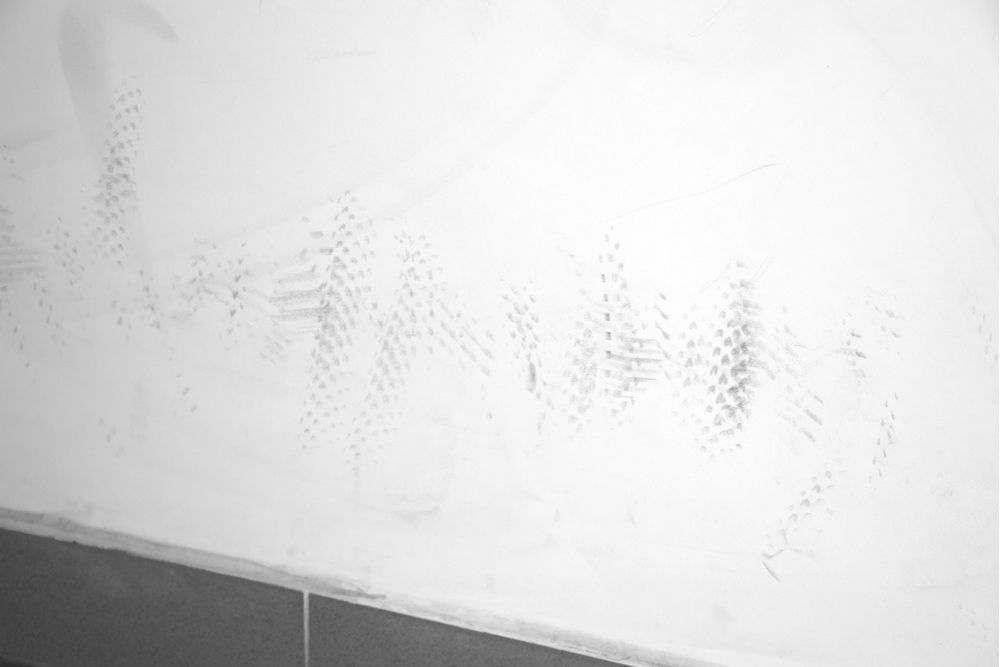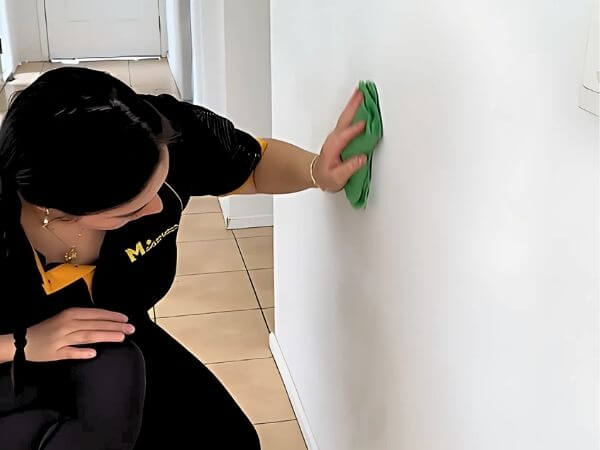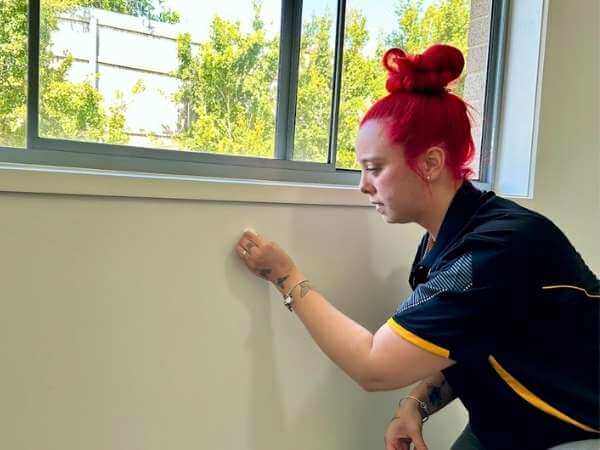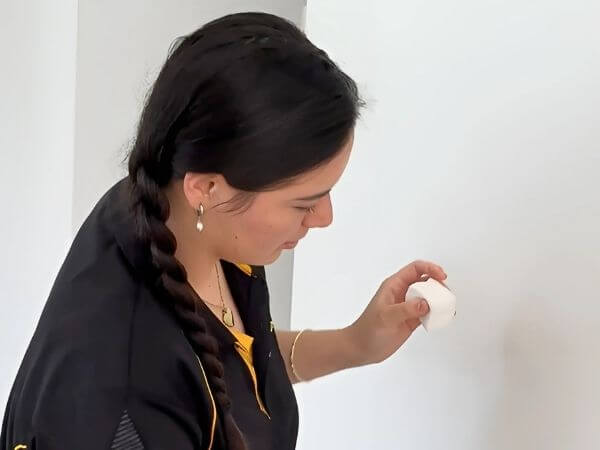Scuff marks have a sneaky way of showing up on walls — they seem to appear right when you’re not looking.
One day, your walls are spotless. Next, there’s a mystery smudge, and you have no idea how it got there.
To remove scuff marks, the safest first step is a soft, damp cloth. You can also use dish soap or baking soda.
But if these didn’t work, don’t stress!
We’ll tell you exactly how to get scuff marks off walls, no matter how tough they are.
Before Cleaning | Steps to Remove Scuff Marks | More Gentle Methods | Solutions for Tough Scuff | Repainting the Wall
What Causes Scuff Marks on Walls?
Scuff marks on walls don’t appear out of nowhere.
They usually show up when something bumps or rubs against the wall and leaves a residue behind.
That’s why you’ll often see scuff marks in high-traffic areas like hallways, kids’ playrooms, and stairways.
Common culprits are everyday items like bags, shoes, and toys. Moving your furniture is also another cause.
The good news is that most scuff marks can be cleaned with common household items.
However, not all scuff marks are just surface stains. Sometimes, the paint or the surface itself gets scratched.
In these cases, scrubbing can make the damage worse. Instead, a touch-up or repaint may be needed.
Before Cleaning Scuff Marks off Walls
When dealing with scuff marks, tackle them as soon as you can. Newer marks are easier to remove than older ones.
Before cleaning your wall, check the kind of surface you’re dealing with.
Glossy and semi-gloss paints are durable. You can usually wipe them without trouble.
However, flat or matte finishes tend to absorb stains and can be trickier to clean. The same goes for brick and unsealed wood.
With wallpaper, be extra gentle.
Vinyl wallpaper can handle some moisture, but paper ones should not be cleaned with liquids.
Moreover, skip abrasive tools and harsh chemicals (no bleach!) to avoid damaging the surface.
Always test the product on an inconspicuous area first, like behind a framed photo.
Use a cotton swab to apply just a bit of the cleaner. Then, wait to see if there’s any damage or discolouration.
And remember: if the surface has been scratched or chipped, it’s better to repaint or repaper the wall instead.
How to Remove Scuff Marks from Walls
To get scuff marks from walls without removing paint, start with the gentlest cleaning methods.
Simple solutions like water and dish soap might be all you need — especially for newer scuff marks.
TIP: The following methods can also work on scuff marks on floors!
Step 1: Prepare the area
Dust the affected area with a dry microfibre cloth or a feather duster.
This keeps you from spreading dirt around as you clean the scuff marks.
Step 2: Wipe with a damp cloth
Sometimes, you can remove fresh scuff marks on walls by simply rubbing them with a damp cloth.
Grab a clean microfibre cloth and dampen it with some cool water. Wring it out well so it’s not dripping.
Gently rub the scuff mark in circular motions, adding a bit of pressure if needed.
Keep going until the scuff lifts.
Once it’s gone, wipe the area dry with a separate clean cloth.
Step 3 (optional): Try dishwashing liquid
If the scuff mark is still on the wall, try the same steps again, but this time with dish soap.
Mix one-half teaspoon of gentle dish soap and two cups of warm water.
This cleaning solution is safe for most types of walls, including painted surfaces.
Dampen a soft cloth or sponge with the soapy water, then gently scrub the scuff until it disappears.
Rinse off any soap residue with a clean, damp cloth. Pat dry with another towel to finish.
Other Gentle Methods to Clean Scuff Marks off Walls
If the methods above didn’t work, there are other gentle options that won’t damage your paint.
1. Baking soda
Baking soda is a mild abrasive that can tackle scuff marks on walls.
Add a little water to the baking soda to make a thick paste.
Use a damp cloth or sponge to apply the baking soda paste onto the scuff mark.
Let it sit for about a minute, then lightly scrub the mark with your cloth or sponge.
When the scuff mark is gone, wipe off the baking soda with a damp cloth.
Dry the area with a clean cloth afterwards.
2. Baby wipes
Baby wipes contain mild cleaning agents that can loosen scuff marks on painted walls!
For this method, choose a plain and unscented baby wipe.
Those with added fragrances or lotions can leave a residue on your wall.
With steady pressure, gently rub the baby wipe over the scuff mark using circular motions.
Once the scuff mark is gone, rinse off the area with a clean, damp cloth.
3. Pencil eraser
For small scuff marks on your wall, try a pencil eraser!
Make sure to use a clean, white eraser without pencil smudge marks.
Avoid coloured erasers, as these might transfer dye to the wall.
To start, gently rub the eraser over the scuff mark in back-and-forth motions.
Keep doing this until the mark is gone.
Once you’re done, brush away any eraser bits from the wall with a clean, dry cloth.
TIP: A pencil eraser can also work on light crayon marks on the wall.
4. Tennis balls
Tennis balls aren’t just for the court. Surprisingly, their felt surface can lift scuff marks from walls!
When rubbed against the wall, the fuzzy surface works like an eraser as it helps loosen dirt.
Just remember to use a clean tennis ball — a grubby one will just make your wall dirtier.
Hold the tennis ball firmly, then rub it over the scuff mark. Add a bit of pressure if needed.
Check from time to time if the mark transfers to the ball’s surface.
Dust the area with a dry rag afterwards to remove any fuzzy residue from the ball.
5. Toothpaste
A white, non-gel toothpaste can work wonders on scuff marks!
Toothpaste contains tiny particles like calcium carbonate or silica, which work like a fine polisher.
Skip gel or coloured toothpaste, as these can stain your wall.
Apply a small amount of toothpaste directly over the scuff mark. Cover the affected area completely.
Then, gently rub the mark with a soft, damp cloth. Keep scrubbing until the mark fades.
When you’re done, remove all traces of toothpaste with a fresh, damp rag.
TIP: Mix toothpaste and baking soda to create a powerful stain remover that can work even on permanent marker stains!
6. White vinegar
White vinegar is a versatile cleaner that can work on scuff marks on walls.
In a bowl, mix equal parts white vinegar and warm water.
Dip a clean microfibre cloth or an old toothbrush into the vinegar solution.
Rub the scuff mark, starting with light pressure and gradually increasing if needed.
For stubborn marks, try using undiluted white vinegar.
Once the mark is gone, use another clean, damp cloth to wipe off any vinegar residue.
How to Remove Stubborn Scuff Marks from Walls
Tried a lot of cleaners that didn’t work?
Don’t worry — there are products that can lift tough dirt, like black scuff marks on walls.
When using stronger solutions, always do a spot test first and wear gloves for protection!
1. All-purpose cleaners
All-purpose cleaners can get rid of scuff marks on walls. Try products like Cif, Goo Gone, and The Pink Stuff.
Read and follow the label when using these cleaners.
As a rule of thumb, it’s safer to apply the product with a soft cloth, rather than directly onto the wall.
Do not scrub too hard to avoid damaging the paint or the surface underneath.
When the scuff is gone, wipe clean with a damp cloth to remove any residue.
2. Melamine sponge
Melamine cleaning sponges are often sold under brand names like “Magic Eraser.”
This cleaning tool is made from melamine foam, which works like fine sandpaper.
It can scrub away scuff marks, but it can also scratch the paint — so use it with care!
Wet a portion of the melamine sponge, and squeeze out the excess water.
Then, gently rub the scuff with light pressure. Check your progress often to see if you’re not causing any damage.
Once the scuff mark disappears, remove any residue from the sponge with a damp cloth.
3. Sugar soap
Sugar soap is a powerful cleaner that can remove scuff marks on walls.
It’s not actually made from sugar, but the powdered form looks like it. You can also find sugar soap in liquid form.
Whichever type you use, you’ll need to mix it with water. Check the product label for the correct dilution ratio.
Dampen a soft cloth or sponge with the sugar soap solution. Then, gently scrub the scuff using small, circular motions.
For tougher marks, you can slightly increase the strength of the mixture.
When you’re done cleaning, rinse the spot with a damp cloth.
4. WD-40
WD-40 isn’t a typical wall cleaner, but surprisingly, it can work on persistent scuff marks.
That said, only use WD-40 if other cleaning methods failed!
Also, WD-40 is not suitable for brick, matte paint, and wallpaper, as it can leave oil stains or cause damage.
Before you begin, open a window or two for ventilation.
Spray a small amount of WD-40 onto a soft cloth, and gently rub the scuff mark.
If the scuff doesn’t budge, hold a cloth underneath the mark and spritz a little WD-40 directly onto the wall.
Let it sit for a few seconds, then gently scrub with a damp cloth.
Once the mark is gone, it’s important to remove all WD-40 residue.
Wipe the area with a cloth dipped in warm, soapy water. Repeat 2–3 times or until the wall no longer feels oily.
Finish by wiping with a clean, damp cloth.
Last Resort: Repainting Your Wall
If you’ve tried everything and the scuff mark is still there, the best solution is to repaint the area.
(Get professional help if the wall has deep scratches or if you’re unsure about your painting skills!)
Start by wiping the wall with a damp cloth to remove any leftover cleaner or dirt. Let it dry completely.
Apply a stain-blocking primer over the scuff mark to make sure it won’t bleed through. Wait for the primer to dry.
For a seamless match, use any leftover paint from a previous project.
If you don’t have any, chip off a small piece of the existing paint. Bring it to a paint store to get the exact match.
When you’re ready, repaint the area. Apply two coats for thorough coverage.
FAQs About Tackling Scuff Marks
No scuff is that tough — here are more tips to get those annoying marks off your wall!
How to get black scuff marks off walls
When cleaning black scuff marks off walls, start with the gentlest method.
First, wipe the scuff with a cloth dampened with plain water.
If the mark lingers, carefully scrub it with a cloth dipped in warm, soapy water.
You can also try:
- Toothpaste
- Baking soda
- All-purpose cleaner
How to clean scuff marks on white walls
When cleaning scuff marks on white walls, start with a damp cloth and plain water.
If needed, use warm water with a bit of dish soap.
Baking soda is also a fantastic abrasive that won’t discolour white paint.
Always clean white walls with care, as damage or stains can show up easily.
Rub lightly to avoid scratching the surface beneath the mark.
And don’t forget to remove all residue with a clean, damp cloth to prevent streaks.
Can nail polish remover lift scuff marks from walls?
Yes, but only as a last resort and with extra care!
Most nail polish removers contain acetone. It’s a strong solvent that can lift scuff marks, but may ruin painted surfaces.
Before using nail polish remover on your wall, test it on a tiny spot.
If it doesn’t cause any damage, apply a little amount onto a cotton pad or a dry white cloth.
This prevents any dye from transferring to the wall.
Gently dab (don’t scrub!) the scuff mark. Once it fades, clean the area with a damp cloth.




